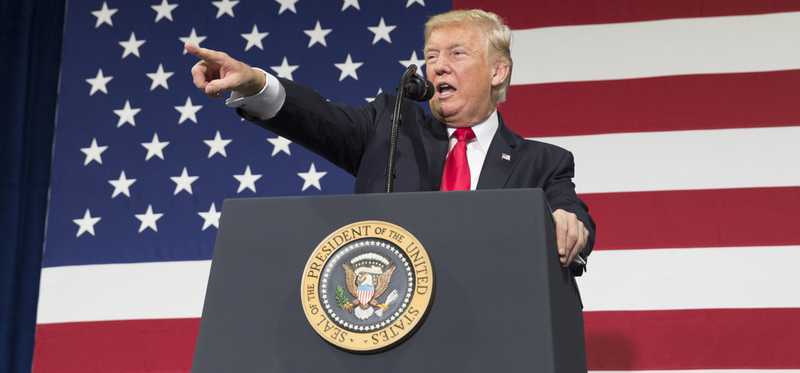10 Market Moving Events That Will Happen in 2019

10 Market Moving Events That Will Happen in 2019
A memorable start to the year could give way to increased volatility
In case you haven’t noticed, the stock market had an incredible to start to 2019. Following a rough end to 2018 that saw stocks dip into their steepest correction in almost a decade, the broad-based S&P 500 (INDEX: ^GSPC) advanced 13.1% in the first quarter. As a whole, this marked its strongest three-month performance in 9.5 years, and was the best first-quarter advance in the benchmark index in 21 years.
But the thing about the stock market is that it’s always forward looking. Future events, not what’s happened in the past, are what’ll wind up moving this market higher or lower. As we look at the remainder of 2019, here are 10 market-moving events bound to lead to volatility.
Previous
Next

1. The U.S.-China trade war
Arguably the biggest market-moving event for the remainder of the year will be the progress, or lack thereof, of a trade deal between the two largest countries by gross domestic product (GDP) in the world: the United States and China.
President Trump has been clear that he wants to minimize or eliminate the United States’ sizable annual trade deficit with China. Meanwhile, Chinese President Xi Jinping has been unwilling to give up too many of China’s inherent advantages that make it a popular choice for technology components and consumer goods. A resolution would be expected at some point given that a protracted trade war with tariffs covering hundreds of billions of dollars in goods won’t be a positive for either the U.S. or Chinese economy. But at this point, neither leader is willing to back down.
ALSO READ: U.S.-China Trade War: Who Will Be Asia's Winners and Losers?
Previous
Next

2. G-20 Summit in Japan
One of the bigger venues this year that’s bound to turn heads is the annual G-20 Summit in Osaka, Japan at the end of June. The G-20 summit features the leaders from 19 developed countries and the European Union, and it represents more than 80% of combined global GDP.
Since bolstering global growth and promoting globalization are the primary goals of the G-20 Summit, it could be the perfect grounds for President’s Trump and Xi to come to an agreement on trade. After all, a slowdown in both U.S. and China GDP growth would almost certainly have an adverse impact on global growth rates.
In addition to focusing on trade and the global economy, the G-20 forum can also set the stage for discussions on climate change. According to the World Resources Institute, just six of the G-20 countries have conveyed how they plan to reduce their carbon emissions between now and 2050. That makes the G-20 a potentially intriguing venue for a company like First Solar (Nasdaq: FSLR), which is one of the largest solar system manufacturers in the world. First Solar’s backlog continues to grow, but it could get considerably larger if other developed nations get on board with clean energy initiatives.
Previous
Next

3. G-7 Summit in France
This coming August, the 45th annual G-7 Summit is taking place in France. As the name implies, the G-7 is a meeting featuring seven of the most influential developed countries in the world: the U.S., Canada, U.K., Germany, France, Japan, and Italy.
While the topics of discussion tend to vary year-to-year, the G-7 summit might dig into climate change, touch on what global trade might look like in a post-Brexit environment, and, if the U.S. and China have yet to reach a trade pact, may lead to the other member nations pressuring President Trump into a trade deal with China.
Also, with Trump having recently concluded a four-day trip to Japan, the G-7 summit could also be grounds for a new trade deal between the U.S. and Japan. The G-7 summit has a lot more on the line in 2019 than in years past, and it’s liable to move the market.
Previous
Next

4. Trump tweets
Although it’s not a single event, there’s no denying that President Trump’s tweets are fully capable of moving the market. Given that Trump often tweets his thoughts on policy, politics, or the economy, multiple times per day, it’s almost a guarantee to be a source of volatility in the months to come.
As an example, Trump’s tweets attacking Federal Reserve Chairperson Jerome Powell for not reducing the federal funds target rate have generally not been well-received by investors. Trump believes that U.S. economic growth would be stronger if the Fed were to lower interest rates, which is something Powell and his Board of Governors haven’t yet considered doing. Criticism of a Fed Chairman by a sitting president is rare, but not under the Trump presidency.
Previous
Next

5. U.S. GDP growth estimates
You can almost certainly count on U.S. quarterly GDP growth figures moving the market. These quarterly growth figures are reported in three estimates, with the final figure often coming out just shy of three months after the preceding quarter ends (i.e., the third estimate for fourth-quarter GDP was released by the Bureau of Economic Analysis on March 28, 2019).
Aside from the mere generalization that Wall Street and investors want to see the U.S. economy continue to expand from an economic standpoint, there’s more on the line with first-, second-, and third-quarter GDP figures in 2019.
Following the passage of Trump’s flagship tax overhaul in December 2017, the Tax Cuts and Jobs Act, the president implied that the U.S. economy would grow by 3% or more each year. While it’s pretty evident that the tax cuts have had a modestly positive impact on U.S. GDP growth thus far, it’s unclear how long this upward bump in growth will last. That makes 2019’s U.S. GDP growth estimates all the more intriguing for investors.
Previous
Next

6. FOMC decisions and discussions
Few events move the market more in the short-term than Federal Open Market Committee (FOMC) meetings. On rare occasion, the release of FOMC meeting minutes, or speeches given by Federal Reserve Governors, can also be market-moving events. The FOMC is responsible for making monetary policy decisions for the nation’s central bank.
For the remainder of 2019, there are five scheduled FOMC meetings (June 18-19, July 30-31, Sept. 17-18, Oct. 29-30, and Dec. 10-11). These meetings, which are often about six to seven weeks apart, involve the Fed Governors discussing the state of the U.S. economy, and deciding whether or not changes should be made the federal funds target rate, which is the rate that banks and credit unions lend to one another overnight. Raising or lowering this rate directly influences the prime rate, which can raise or lower the short-term interest rate banks charge consumers. It also indirectly influences longer-term interest rates, including mortgage and savings rates.
With President Trump harping on the Fed to lower rates, but little in the way of inflation present at the moment, it’s anyone’s guess what the remaining five FOMC decisions will yield in 2019.
Previous
Next

7. Democratic Party primaries
As much as some folks would rather avoid politics at all costs, the 2020 presidential election in the U.S. is going to play a big role in moving the markets. With Trump having declared his intent to run for a second term on the Republican ticket, it now comes down to which one of nearly two-dozen Democrats to have declared for the presidency will emerge.
On one hand, a more centrist Democratic candidate like Joe Biden is unlikely to make substantive changes to the U.S. tax code if he wins Democratic ticket and 2020 election.
Meanwhile, if Senators Bernie Sanders (I-Vermont) or Elizabeth Warren (D-Mass.) were to win the Democratic nomination and, subsequently, the presidency, the expectation of a major overhaul of the U.S. tax code in the opposite direction of what Trump has brought to the corporate world over the past year and a half would be a lot higher. There’s going to be a lot of volatility surrounding the 2020 election until the market knows who that Democratic nominee will be, so expect the Democratic field chess match and early debates to move markets in 2019.
Previous
Next

8. The election of Britain’s new prime minister
On May 24, British Prime Minister Theresa May announced that after three years at the helm she would resign, effective June 7. May’s resignation comes on the heels of multiple unsuccessful attempts to work out trade deals with Britain’s closest European allies in order to facilitate “Brexit” -- the exit of the U.K. from the European Union, as voted upon by Britain’s citizens in 2016.
The big question now becomes who will step in as the new Prime Minister in Britain. Conservative members of Parliament will nominate and vote for their preferred candidate(s) throughout most of June, with the two most-favored candidates expected to face a wider party vote before Parliament breaks for its summer recess on July 20. The new prime minister will be tasked with handling Brexit in the months to come, with both the seniority of the new leader and their ideology toward Britain’s exit from the EU expected to shape how the market reacts.
Previous
Next

9. OPEC meetings
Although it’s easy to focus on domestic matters, upcoming meetings for the Organization of Petroleum Exporting Countries, which we affably know as OPEC, could have quite the impact on our own and global stock markets. The next meeting for OPEC is slated for late June.
OPEC is comprised of 14 member countries responsible for producing more than 40% of the world’s oil. Late last year, the member countries of OPEC, as well as a handful of non-OPEC allies, agreed to cut production, removing about 1.2 million barrels of oil per day from the market. This move was made to help reduce global oversupply which should, according to supply-and-demand economics, help prop up crude prices.
The big question is, “What happens come June?” According to Saudi Arabia’s Energy Minister Khalid al-Falih in an interview with CNBC, it’s unlikely that OPEC leaves the oil market “unguided in the second half” of the year. This suggests that, depending upon how OPEC and its allies view global oil supply, we could see a production shift within the next couple of weeks. That could have big implications for the U.S. and global energy markets.
ALSO READ: Forget OPEC: This Is an Even Bigger Catalyst for Oil Stocks
Previous
Next

10. An SEC decision on bitcoin ETFs
While it might sound crazy, an upcoming Securities and Exchange Commission (SEC) decision on whether or not to allow bitcoin exchange-traded funds (ETFs) to list their shares on major U.S. exchanges could turn out to be a market-moving event.
Bitcoin, the largest cryptocurrency in the world, has been an exceptionally volatile asset over the past couple of years. There are, however, very few ways for the average investor to invest in cryptocurrencies like bitcoin, should they choose to do so, on major exchanges. Most bitcoin purchases are made today on unregulated cryptocurrency exchanges.
That may soon change, with the SEC currently seeking public comment and rebuttals on whether or not to allow bitcoin ETFs to list their shares on major exchanges. The decision, which has been delayed multiple times but is expected in August, could funnel plenty of extra capital into the cryptocurrency markets, which, in turn, may come at the expense of traditional equity markets.
Previous
Next

Volatility aside, this is your smartest move as an investor
Though there are no shortage of market-moving events for the remainder of 2019 that could send the market soaring or plunging, the important thing for investors to remember is to stay the course.
Since 1950, according to data from Yardeni Research, there have been 37 stock market corrections of at least 10%, not including rounding, in the broad-based S&P 500. But here’s the interesting fact: Each and every one of these corrections has eventually been put into the rearview mirror by a bull-market rally.
No matter how bleak the outlook for equities, dips in the stock market have always represented a solid opportunity to buy. And as long as you purchase a diversified basket of high-quality stocks, the data shows you have a very good chance of coming out a winner over the long run.
Sean Williams has no position in any of the stocks mentioned. The Motley Fool recommends First Solar. The Motley Fool has a disclosure policy.
Previous
Next
Invest Smarter with The Motley Fool
Join Over Half a Million Premium Members Receiving…
- New Stock Picks Each Month
- Detailed Analysis of Companies
- Model Portfolios
- Live Streaming During Market Hours
- And Much More
READ MORE
HOW THE MOTLEY FOOL CAN HELP YOU
-
Premium Investing Guidance
Market beating stocks from our award-winning service
-
The Daily Upside Newsletter
Investment news and high-quality insights delivered straight to your inbox
-
Get Started Investing
You can do it. Successful investing in just a few steps
-
Win at Retirement
Secrets and strategies for the post-work life you want.
-
Find a Broker
Find the right brokerage account for you.
-
Listen to our Podcasts
Hear our experts take on stocks, the market, and how to invest.
Premium Investing Services
Invest better with The Motley Fool. Get stock recommendations, portfolio guidance, and more from The Motley Fool's premium services.